A Survival Analysis of Patients with Recurrent Epithelial Ovarian Cancer Based on Relapse Type: A Multi-Institutional Retrospective Study in Armenia
- PMID: 38534933
- PMCID: PMC10968888
- DOI: 10.3390/curroncol31030100
A Survival Analysis of Patients with Recurrent Epithelial Ovarian Cancer Based on Relapse Type: A Multi-Institutional Retrospective Study in Armenia
Abstract
Background: Annually, approximately 200 new ovarian cancer cases are diagnosed in Armenia, which is considered an upper-middle-income country. This study aimed to summarize the survival outcomes of patients with relapsed ovarian cancer in Armenia based on the type of recurrence, risk factors, and choice of systemic treatment.
Methods: This retrospective case-control study included 228 patients with relapsed ovarian cancer from three different institutions.
Results: The median age of the patients was 55. The median follow-up times from relapse and primary diagnosis were 21 and 48 months, respectively. The incidence of platinum-sensitive relapse was 81.6% (186), while platinum-resistant relapse was observed in only 18.4% (42) of patients. The median post-progression survival of the platinum-sensitive group compared to the platinum-resistant group was 54 vs. 25 months (p < 0.001), respectively, while the median survival after relapse was 25 vs. 13 months, respectively; three- and five-year post-progression survival rates in these groups were 31.2% vs. 23.8%, and 15.1% vs. 9.5%, respectively (p = 0.113).
Conclusions: Overall, despite new therapeutic approaches, ovarian cancer continues to be one of the deadly malignant diseases affecting women, especially in developing countries with a lack of resources, where chemotherapy remains the primary available systemic treatment for the majority of patients. Low survival rates demonstrate the urgent need for more research focused on this group of patients with poor outcomes.
Keywords: chemotherapy; platinum-refractory relapse; platinum-resistant relapse; platinum-sensitive relapse; recurrent ovarian cancer; targeted therapy.
Conflict of interest statement
L.H. reports lecture fees and travel support from Roche and Novartis Pharmaceuticals outside of the submitted work.
Figures





References
-
- Cabasag C.J., Fagan P.J., Ferlay J., Vignat J., Laversanne M., Liu L., van der Aa M.A., Bray F., Soerjomataram I. Ovarian Cancer Today and Tomorrow: A Global Assessment by World Region and Human Development Index Using GLOBOCAN 2020. Int. J. Cancer. 2022;151:1535–1541. doi: 10.1002/ijc.34002. - DOI - PubMed
-
- Ovarian Cancer By The Numbers|OCRA. [(accessed on 10 February 2024)]. Available online: https://ocrahope.org/get-the-facts/statistics/
-
- Ovarian Cancer Statistics|How Common is Ovarian Cancer|American Cancer Society. [(accessed on 10 February 2024)]. Available online: https://www.cancer.org/cancer/types/ovarian-cancer/about/key-statistics.....
-
- Statistical Committee of the Republic of Armenia Statistical Yearbook of Armenia 2023: Health and Healthcare. [(accessed on 10 February 2024)]. Available online: https://nih.am/assets/pdf/atvk/2d5537b6227666a32f97571d7dd15420.pdf.
-
- NCCN Clinical Practice Guidelines in Oncology. Ovarian Cancer/Fallopian Tube Cancer/Primary Peritoneal Cancer, Version 1.2024. [(accessed on 10 February 2024)]. Available online: https://www.nccn.org/professionals/physician_gls/pdf/ovarian.pdf.
Publication types
MeSH terms
LinkOut - more resources
Full Text Sources
Medical

